Nursing Ethics Case Studies: Privacy, Infection, and Substance Abuse
VerifiedAdded on 2022/09/14
|10
|3612
|10
Case Study
AI Summary
This case study assignment explores critical ethical issues in nursing through three distinct scenarios. The first case examines a registered nurse's breach of patient privacy by involving a student in a gynecological procedure without the patient's consent, highlighting violations of ethical values and Australian privacy laws. The second case focuses on infection control deficiencies within a hospital, particularly the reuse of injection caps, leading to potential patient harm and breaches of professional conduct, emphasizing the importance of hygiene and safe practices. The final case addresses substance abuse among nursing students, impacting their ability to perform duties and maintain professional relationships, underlining the consequences of impaired judgment and the need for adherence to ethical standards. The assignment emphasizes the importance of ethical decision-making, patient confidentiality, and professional conduct in nursing practice, referencing relevant legislation and codes of ethics to guide healthcare professionals in navigating complex ethical dilemmas and ensuring positive patient outcomes.
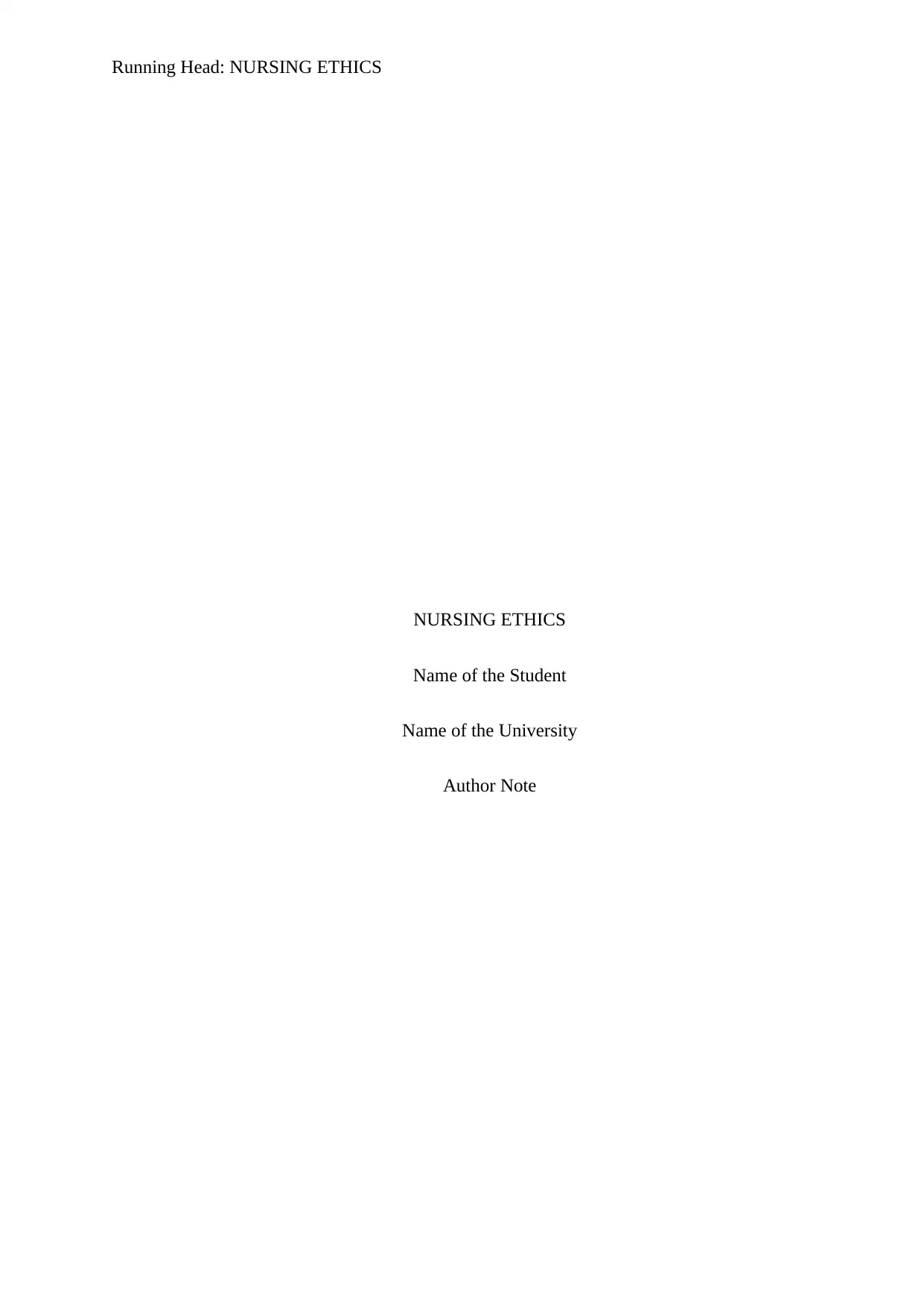
Running Head: NURSING ETHICS
NURSING ETHICS
Name of the Student
Name of the University
Author Note
NURSING ETHICS
Name of the Student
Name of the University
Author Note
Paraphrase This Document
Need a fresh take? Get an instant paraphrase of this document with our AI Paraphraser
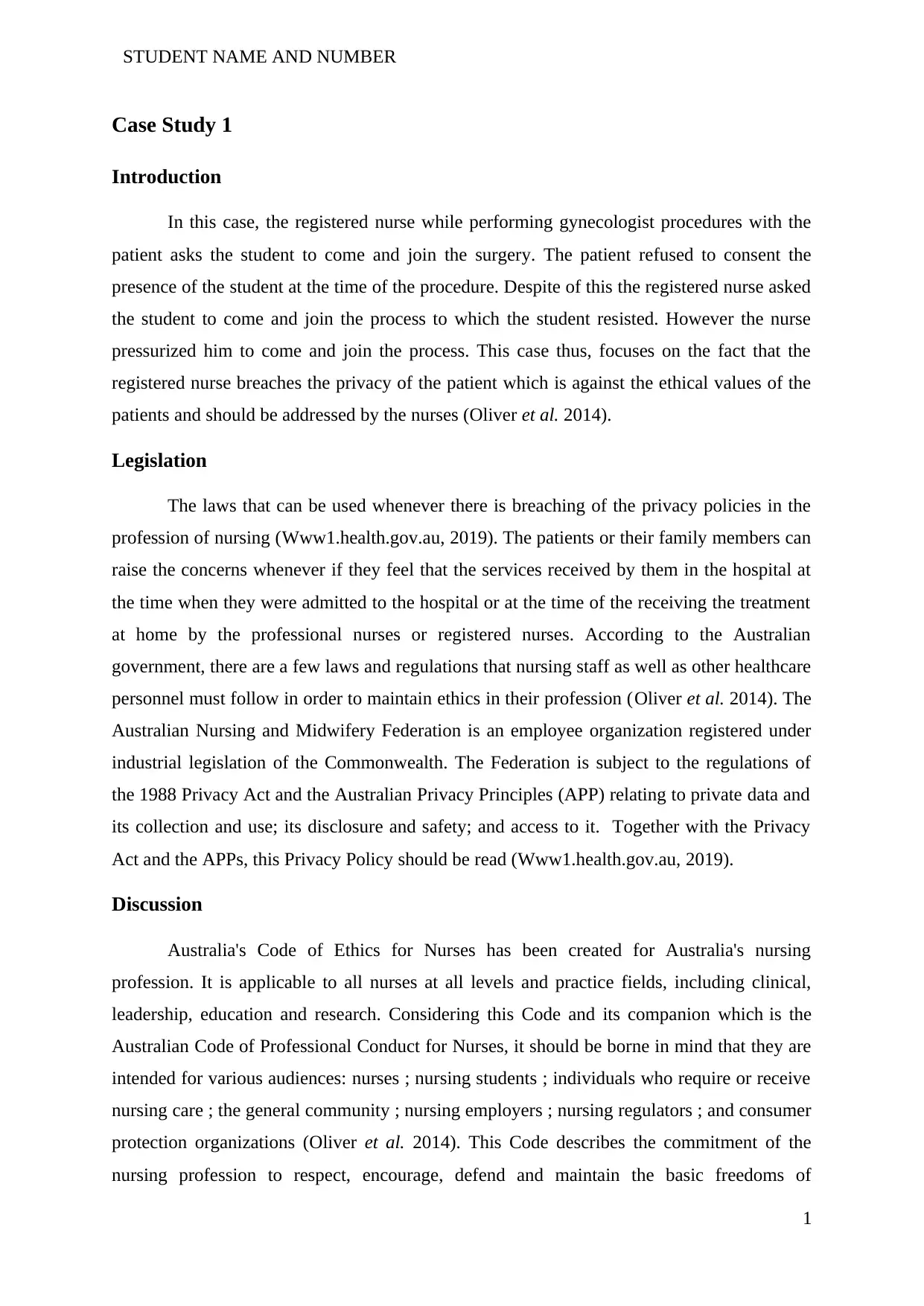
STUDENT NAME AND NUMBER
Case Study 1
Introduction
In this case, the registered nurse while performing gynecologist procedures with the
patient asks the student to come and join the surgery. The patient refused to consent the
presence of the student at the time of the procedure. Despite of this the registered nurse asked
the student to come and join the process to which the student resisted. However the nurse
pressurized him to come and join the process. This case thus, focuses on the fact that the
registered nurse breaches the privacy of the patient which is against the ethical values of the
patients and should be addressed by the nurses (Oliver et al. 2014).
Legislation
The laws that can be used whenever there is breaching of the privacy policies in the
profession of nursing (Www1.health.gov.au, 2019). The patients or their family members can
raise the concerns whenever if they feel that the services received by them in the hospital at
the time when they were admitted to the hospital or at the time of the receiving the treatment
at home by the professional nurses or registered nurses. According to the Australian
government, there are a few laws and regulations that nursing staff as well as other healthcare
personnel must follow in order to maintain ethics in their profession (Oliver et al. 2014). The
Australian Nursing and Midwifery Federation is an employee organization registered under
industrial legislation of the Commonwealth. The Federation is subject to the regulations of
the 1988 Privacy Act and the Australian Privacy Principles (APP) relating to private data and
its collection and use; its disclosure and safety; and access to it. Together with the Privacy
Act and the APPs, this Privacy Policy should be read (Www1.health.gov.au, 2019).
Discussion
Australia's Code of Ethics for Nurses has been created for Australia's nursing
profession. It is applicable to all nurses at all levels and practice fields, including clinical,
leadership, education and research. Considering this Code and its companion which is the
Australian Code of Professional Conduct for Nurses, it should be borne in mind that they are
intended for various audiences: nurses ; nursing students ; individuals who require or receive
nursing care ; the general community ; nursing employers ; nursing regulators ; and consumer
protection organizations (Oliver et al. 2014). This Code describes the commitment of the
nursing profession to respect, encourage, defend and maintain the basic freedoms of
1
Case Study 1
Introduction
In this case, the registered nurse while performing gynecologist procedures with the
patient asks the student to come and join the surgery. The patient refused to consent the
presence of the student at the time of the procedure. Despite of this the registered nurse asked
the student to come and join the process to which the student resisted. However the nurse
pressurized him to come and join the process. This case thus, focuses on the fact that the
registered nurse breaches the privacy of the patient which is against the ethical values of the
patients and should be addressed by the nurses (Oliver et al. 2014).
Legislation
The laws that can be used whenever there is breaching of the privacy policies in the
profession of nursing (Www1.health.gov.au, 2019). The patients or their family members can
raise the concerns whenever if they feel that the services received by them in the hospital at
the time when they were admitted to the hospital or at the time of the receiving the treatment
at home by the professional nurses or registered nurses. According to the Australian
government, there are a few laws and regulations that nursing staff as well as other healthcare
personnel must follow in order to maintain ethics in their profession (Oliver et al. 2014). The
Australian Nursing and Midwifery Federation is an employee organization registered under
industrial legislation of the Commonwealth. The Federation is subject to the regulations of
the 1988 Privacy Act and the Australian Privacy Principles (APP) relating to private data and
its collection and use; its disclosure and safety; and access to it. Together with the Privacy
Act and the APPs, this Privacy Policy should be read (Www1.health.gov.au, 2019).
Discussion
Australia's Code of Ethics for Nurses has been created for Australia's nursing
profession. It is applicable to all nurses at all levels and practice fields, including clinical,
leadership, education and research. Considering this Code and its companion which is the
Australian Code of Professional Conduct for Nurses, it should be borne in mind that they are
intended for various audiences: nurses ; nursing students ; individuals who require or receive
nursing care ; the general community ; nursing employers ; nursing regulators ; and consumer
protection organizations (Oliver et al. 2014). This Code describes the commitment of the
nursing profession to respect, encourage, defend and maintain the basic freedoms of
1
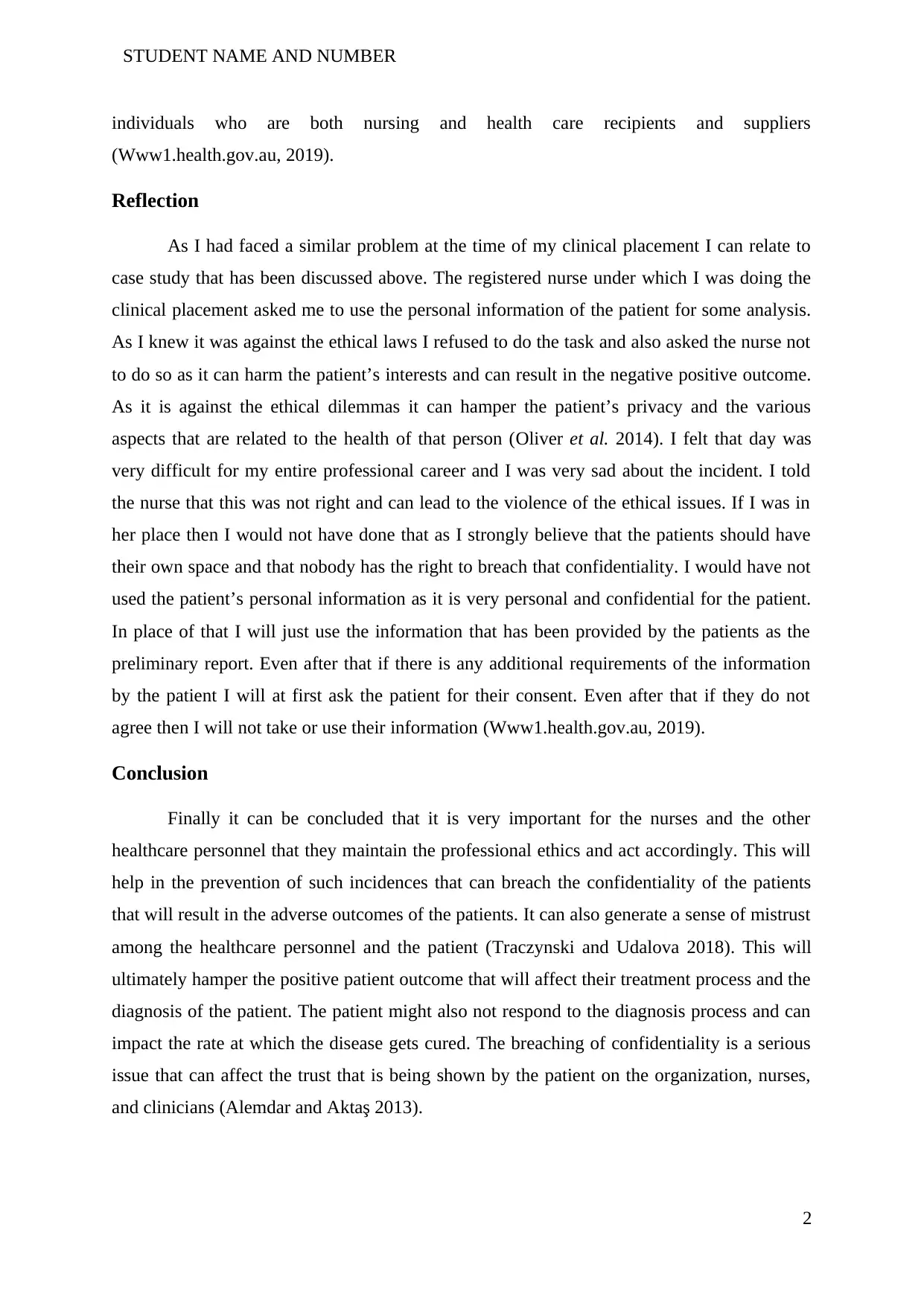
STUDENT NAME AND NUMBER
individuals who are both nursing and health care recipients and suppliers
(Www1.health.gov.au, 2019).
Reflection
As I had faced a similar problem at the time of my clinical placement I can relate to
case study that has been discussed above. The registered nurse under which I was doing the
clinical placement asked me to use the personal information of the patient for some analysis.
As I knew it was against the ethical laws I refused to do the task and also asked the nurse not
to do so as it can harm the patient’s interests and can result in the negative positive outcome.
As it is against the ethical dilemmas it can hamper the patient’s privacy and the various
aspects that are related to the health of that person (Oliver et al. 2014). I felt that day was
very difficult for my entire professional career and I was very sad about the incident. I told
the nurse that this was not right and can lead to the violence of the ethical issues. If I was in
her place then I would not have done that as I strongly believe that the patients should have
their own space and that nobody has the right to breach that confidentiality. I would have not
used the patient’s personal information as it is very personal and confidential for the patient.
In place of that I will just use the information that has been provided by the patients as the
preliminary report. Even after that if there is any additional requirements of the information
by the patient I will at first ask the patient for their consent. Even after that if they do not
agree then I will not take or use their information (Www1.health.gov.au, 2019).
Conclusion
Finally it can be concluded that it is very important for the nurses and the other
healthcare personnel that they maintain the professional ethics and act accordingly. This will
help in the prevention of such incidences that can breach the confidentiality of the patients
that will result in the adverse outcomes of the patients. It can also generate a sense of mistrust
among the healthcare personnel and the patient (Traczynski and Udalova 2018). This will
ultimately hamper the positive patient outcome that will affect their treatment process and the
diagnosis of the patient. The patient might also not respond to the diagnosis process and can
impact the rate at which the disease gets cured. The breaching of confidentiality is a serious
issue that can affect the trust that is being shown by the patient on the organization, nurses,
and clinicians (Alemdar and Aktaş 2013).
2
individuals who are both nursing and health care recipients and suppliers
(Www1.health.gov.au, 2019).
Reflection
As I had faced a similar problem at the time of my clinical placement I can relate to
case study that has been discussed above. The registered nurse under which I was doing the
clinical placement asked me to use the personal information of the patient for some analysis.
As I knew it was against the ethical laws I refused to do the task and also asked the nurse not
to do so as it can harm the patient’s interests and can result in the negative positive outcome.
As it is against the ethical dilemmas it can hamper the patient’s privacy and the various
aspects that are related to the health of that person (Oliver et al. 2014). I felt that day was
very difficult for my entire professional career and I was very sad about the incident. I told
the nurse that this was not right and can lead to the violence of the ethical issues. If I was in
her place then I would not have done that as I strongly believe that the patients should have
their own space and that nobody has the right to breach that confidentiality. I would have not
used the patient’s personal information as it is very personal and confidential for the patient.
In place of that I will just use the information that has been provided by the patients as the
preliminary report. Even after that if there is any additional requirements of the information
by the patient I will at first ask the patient for their consent. Even after that if they do not
agree then I will not take or use their information (Www1.health.gov.au, 2019).
Conclusion
Finally it can be concluded that it is very important for the nurses and the other
healthcare personnel that they maintain the professional ethics and act accordingly. This will
help in the prevention of such incidences that can breach the confidentiality of the patients
that will result in the adverse outcomes of the patients. It can also generate a sense of mistrust
among the healthcare personnel and the patient (Traczynski and Udalova 2018). This will
ultimately hamper the positive patient outcome that will affect their treatment process and the
diagnosis of the patient. The patient might also not respond to the diagnosis process and can
impact the rate at which the disease gets cured. The breaching of confidentiality is a serious
issue that can affect the trust that is being shown by the patient on the organization, nurses,
and clinicians (Alemdar and Aktaş 2013).
2
⊘ This is a preview!⊘
Do you want full access?
Subscribe today to unlock all pages.

Trusted by 1+ million students worldwide
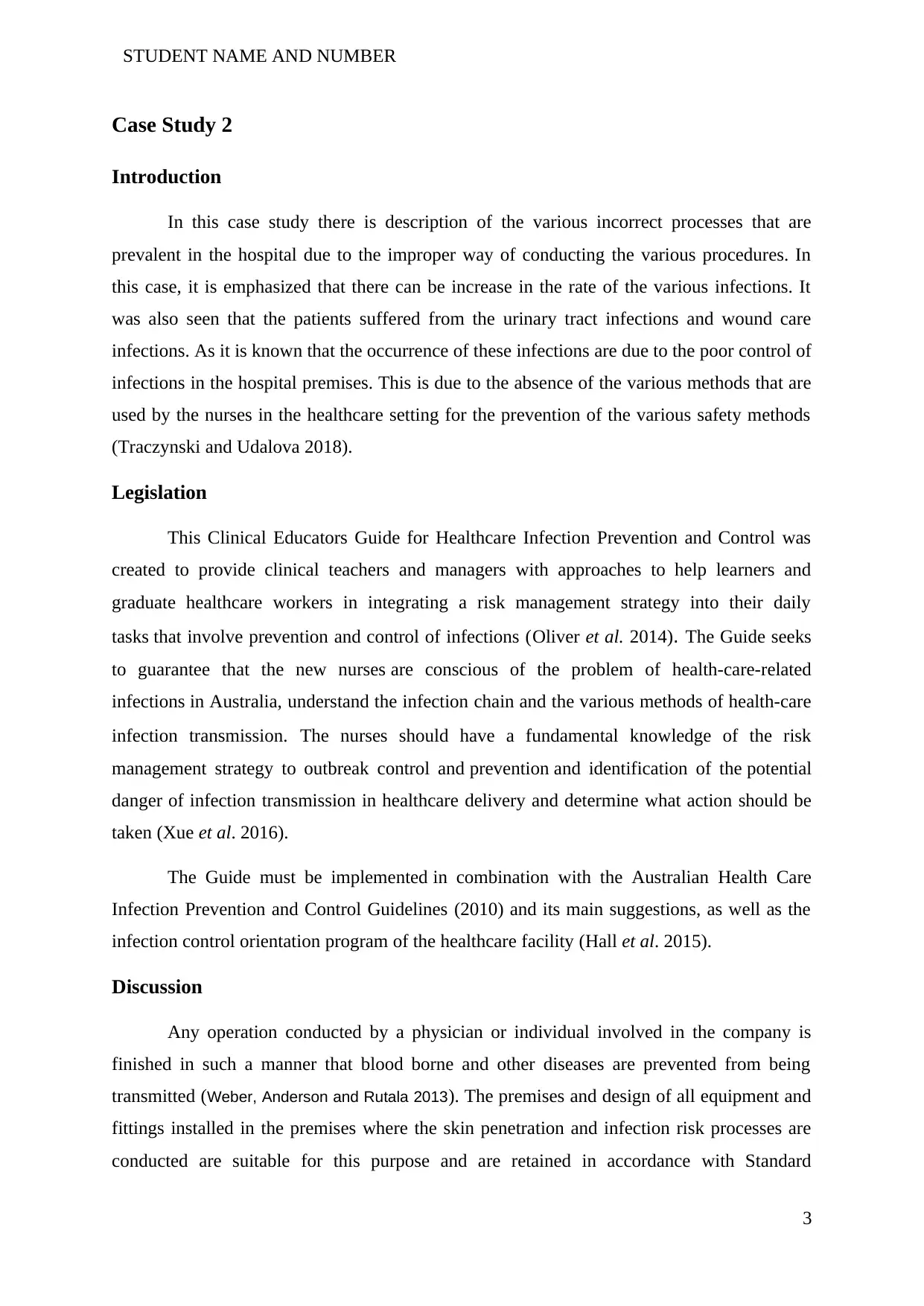
STUDENT NAME AND NUMBER
Case Study 2
Introduction
In this case study there is description of the various incorrect processes that are
prevalent in the hospital due to the improper way of conducting the various procedures. In
this case, it is emphasized that there can be increase in the rate of the various infections. It
was also seen that the patients suffered from the urinary tract infections and wound care
infections. As it is known that the occurrence of these infections are due to the poor control of
infections in the hospital premises. This is due to the absence of the various methods that are
used by the nurses in the healthcare setting for the prevention of the various safety methods
(Traczynski and Udalova 2018).
Legislation
This Clinical Educators Guide for Healthcare Infection Prevention and Control was
created to provide clinical teachers and managers with approaches to help learners and
graduate healthcare workers in integrating a risk management strategy into their daily
tasks that involve prevention and control of infections (Oliver et al. 2014). The Guide seeks
to guarantee that the new nurses are conscious of the problem of health-care-related
infections in Australia, understand the infection chain and the various methods of health-care
infection transmission. The nurses should have a fundamental knowledge of the risk
management strategy to outbreak control and prevention and identification of the potential
danger of infection transmission in healthcare delivery and determine what action should be
taken (Xue et al. 2016).
The Guide must be implemented in combination with the Australian Health Care
Infection Prevention and Control Guidelines (2010) and its main suggestions, as well as the
infection control orientation program of the healthcare facility (Hall et al. 2015).
Discussion
Any operation conducted by a physician or individual involved in the company is
finished in such a manner that blood borne and other diseases are prevented from being
transmitted (Weber, Anderson and Rutala 2013). The premises and design of all equipment and
fittings installed in the premises where the skin penetration and infection risk processes are
conducted are suitable for this purpose and are retained in accordance with Standard
3
Case Study 2
Introduction
In this case study there is description of the various incorrect processes that are
prevalent in the hospital due to the improper way of conducting the various procedures. In
this case, it is emphasized that there can be increase in the rate of the various infections. It
was also seen that the patients suffered from the urinary tract infections and wound care
infections. As it is known that the occurrence of these infections are due to the poor control of
infections in the hospital premises. This is due to the absence of the various methods that are
used by the nurses in the healthcare setting for the prevention of the various safety methods
(Traczynski and Udalova 2018).
Legislation
This Clinical Educators Guide for Healthcare Infection Prevention and Control was
created to provide clinical teachers and managers with approaches to help learners and
graduate healthcare workers in integrating a risk management strategy into their daily
tasks that involve prevention and control of infections (Oliver et al. 2014). The Guide seeks
to guarantee that the new nurses are conscious of the problem of health-care-related
infections in Australia, understand the infection chain and the various methods of health-care
infection transmission. The nurses should have a fundamental knowledge of the risk
management strategy to outbreak control and prevention and identification of the potential
danger of infection transmission in healthcare delivery and determine what action should be
taken (Xue et al. 2016).
The Guide must be implemented in combination with the Australian Health Care
Infection Prevention and Control Guidelines (2010) and its main suggestions, as well as the
infection control orientation program of the healthcare facility (Hall et al. 2015).
Discussion
Any operation conducted by a physician or individual involved in the company is
finished in such a manner that blood borne and other diseases are prevented from being
transmitted (Weber, Anderson and Rutala 2013). The premises and design of all equipment and
fittings installed in the premises where the skin penetration and infection risk processes are
conducted are suitable for this purpose and are retained in accordance with Standard
3
Paraphrase This Document
Need a fresh take? Get an instant paraphrase of this document with our AI Paraphraser
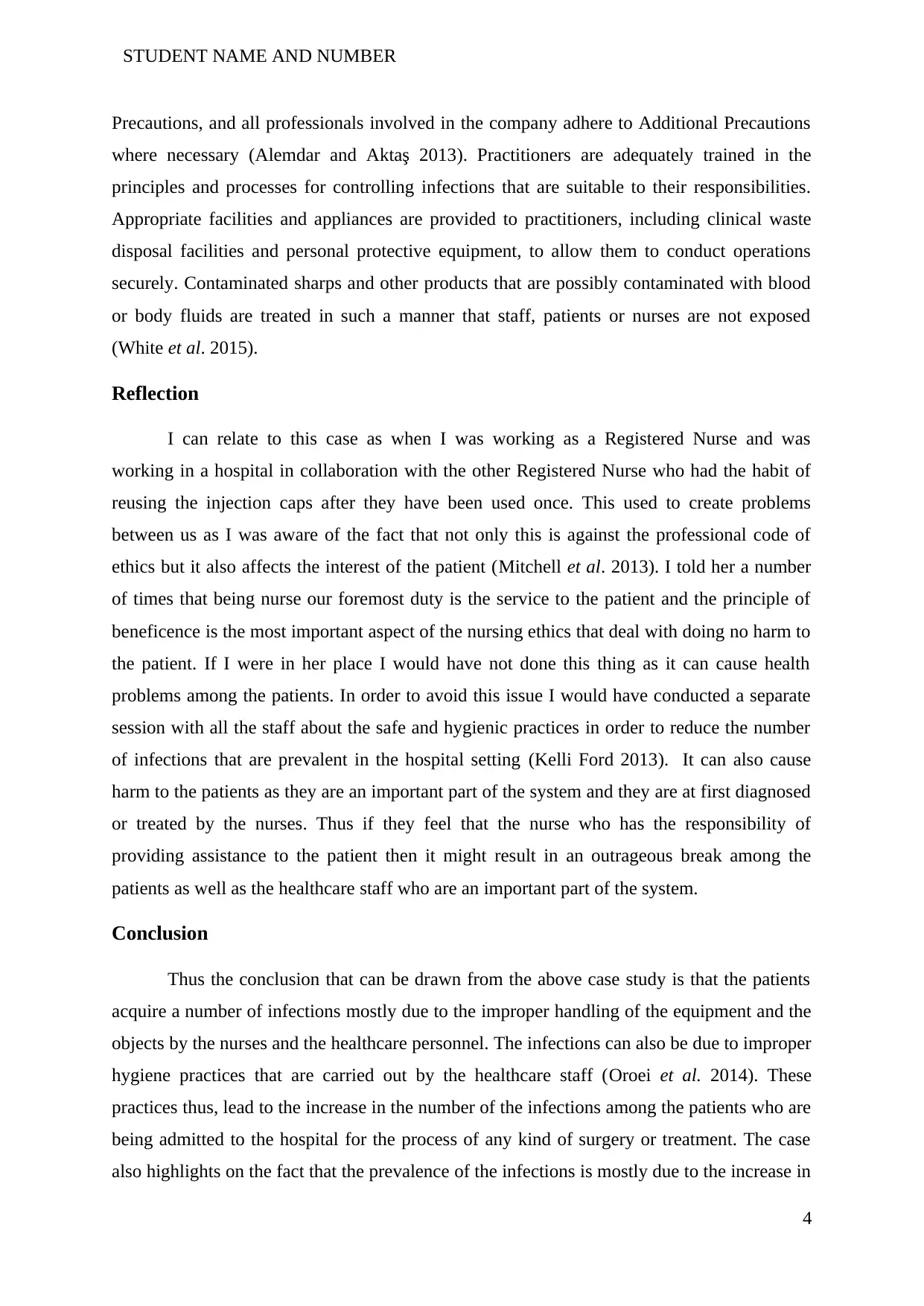
STUDENT NAME AND NUMBER
Precautions, and all professionals involved in the company adhere to Additional Precautions
where necessary (Alemdar and Aktaş 2013). Practitioners are adequately trained in the
principles and processes for controlling infections that are suitable to their responsibilities.
Appropriate facilities and appliances are provided to practitioners, including clinical waste
disposal facilities and personal protective equipment, to allow them to conduct operations
securely. Contaminated sharps and other products that are possibly contaminated with blood
or body fluids are treated in such a manner that staff, patients or nurses are not exposed
(White et al. 2015).
Reflection
I can relate to this case as when I was working as a Registered Nurse and was
working in a hospital in collaboration with the other Registered Nurse who had the habit of
reusing the injection caps after they have been used once. This used to create problems
between us as I was aware of the fact that not only this is against the professional code of
ethics but it also affects the interest of the patient (Mitchell et al. 2013). I told her a number
of times that being nurse our foremost duty is the service to the patient and the principle of
beneficence is the most important aspect of the nursing ethics that deal with doing no harm to
the patient. If I were in her place I would have not done this thing as it can cause health
problems among the patients. In order to avoid this issue I would have conducted a separate
session with all the staff about the safe and hygienic practices in order to reduce the number
of infections that are prevalent in the hospital setting (Kelli Ford 2013). It can also cause
harm to the patients as they are an important part of the system and they are at first diagnosed
or treated by the nurses. Thus if they feel that the nurse who has the responsibility of
providing assistance to the patient then it might result in an outrageous break among the
patients as well as the healthcare staff who are an important part of the system.
Conclusion
Thus the conclusion that can be drawn from the above case study is that the patients
acquire a number of infections mostly due to the improper handling of the equipment and the
objects by the nurses and the healthcare personnel. The infections can also be due to improper
hygiene practices that are carried out by the healthcare staff (Oroei et al. 2014). These
practices thus, lead to the increase in the number of the infections among the patients who are
being admitted to the hospital for the process of any kind of surgery or treatment. The case
also highlights on the fact that the prevalence of the infections is mostly due to the increase in
4
Precautions, and all professionals involved in the company adhere to Additional Precautions
where necessary (Alemdar and Aktaş 2013). Practitioners are adequately trained in the
principles and processes for controlling infections that are suitable to their responsibilities.
Appropriate facilities and appliances are provided to practitioners, including clinical waste
disposal facilities and personal protective equipment, to allow them to conduct operations
securely. Contaminated sharps and other products that are possibly contaminated with blood
or body fluids are treated in such a manner that staff, patients or nurses are not exposed
(White et al. 2015).
Reflection
I can relate to this case as when I was working as a Registered Nurse and was
working in a hospital in collaboration with the other Registered Nurse who had the habit of
reusing the injection caps after they have been used once. This used to create problems
between us as I was aware of the fact that not only this is against the professional code of
ethics but it also affects the interest of the patient (Mitchell et al. 2013). I told her a number
of times that being nurse our foremost duty is the service to the patient and the principle of
beneficence is the most important aspect of the nursing ethics that deal with doing no harm to
the patient. If I were in her place I would have not done this thing as it can cause health
problems among the patients. In order to avoid this issue I would have conducted a separate
session with all the staff about the safe and hygienic practices in order to reduce the number
of infections that are prevalent in the hospital setting (Kelli Ford 2013). It can also cause
harm to the patients as they are an important part of the system and they are at first diagnosed
or treated by the nurses. Thus if they feel that the nurse who has the responsibility of
providing assistance to the patient then it might result in an outrageous break among the
patients as well as the healthcare staff who are an important part of the system.
Conclusion
Thus the conclusion that can be drawn from the above case study is that the patients
acquire a number of infections mostly due to the improper handling of the equipment and the
objects by the nurses and the healthcare personnel. The infections can also be due to improper
hygiene practices that are carried out by the healthcare staff (Oroei et al. 2014). These
practices thus, lead to the increase in the number of the infections among the patients who are
being admitted to the hospital for the process of any kind of surgery or treatment. The case
also highlights on the fact that the prevalence of the infections is mostly due to the increase in
4
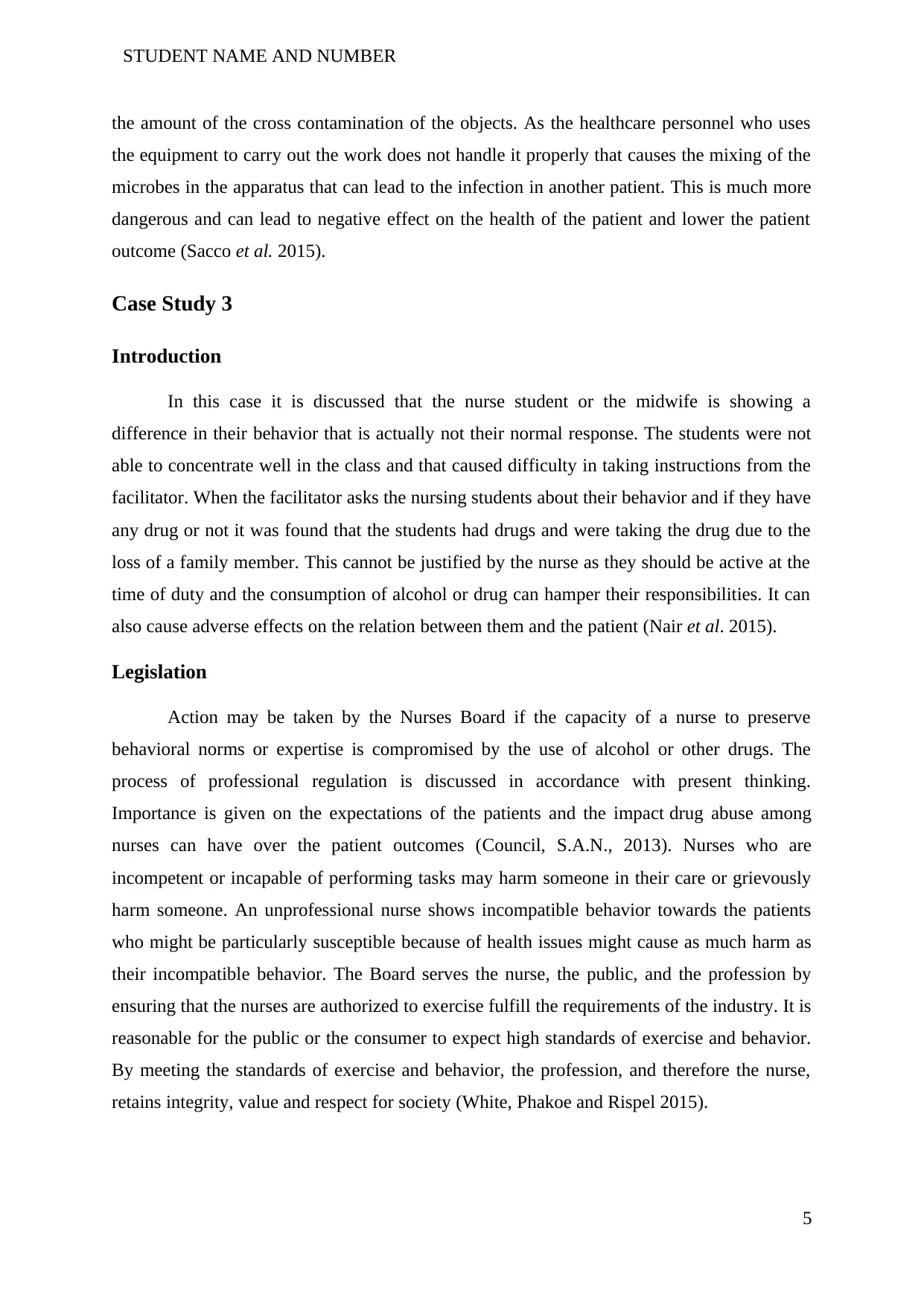
STUDENT NAME AND NUMBER
the amount of the cross contamination of the objects. As the healthcare personnel who uses
the equipment to carry out the work does not handle it properly that causes the mixing of the
microbes in the apparatus that can lead to the infection in another patient. This is much more
dangerous and can lead to negative effect on the health of the patient and lower the patient
outcome (Sacco et al. 2015).
Case Study 3
Introduction
In this case it is discussed that the nurse student or the midwife is showing a
difference in their behavior that is actually not their normal response. The students were not
able to concentrate well in the class and that caused difficulty in taking instructions from the
facilitator. When the facilitator asks the nursing students about their behavior and if they have
any drug or not it was found that the students had drugs and were taking the drug due to the
loss of a family member. This cannot be justified by the nurse as they should be active at the
time of duty and the consumption of alcohol or drug can hamper their responsibilities. It can
also cause adverse effects on the relation between them and the patient (Nair et al. 2015).
Legislation
Action may be taken by the Nurses Board if the capacity of a nurse to preserve
behavioral norms or expertise is compromised by the use of alcohol or other drugs. The
process of professional regulation is discussed in accordance with present thinking.
Importance is given on the expectations of the patients and the impact drug abuse among
nurses can have over the patient outcomes (Council, S.A.N., 2013). Nurses who are
incompetent or incapable of performing tasks may harm someone in their care or grievously
harm someone. An unprofessional nurse shows incompatible behavior towards the patients
who might be particularly susceptible because of health issues might cause as much harm as
their incompatible behavior. The Board serves the nurse, the public, and the profession by
ensuring that the nurses are authorized to exercise fulfill the requirements of the industry. It is
reasonable for the public or the consumer to expect high standards of exercise and behavior.
By meeting the standards of exercise and behavior, the profession, and therefore the nurse,
retains integrity, value and respect for society (White, Phakoe and Rispel 2015).
5
the amount of the cross contamination of the objects. As the healthcare personnel who uses
the equipment to carry out the work does not handle it properly that causes the mixing of the
microbes in the apparatus that can lead to the infection in another patient. This is much more
dangerous and can lead to negative effect on the health of the patient and lower the patient
outcome (Sacco et al. 2015).
Case Study 3
Introduction
In this case it is discussed that the nurse student or the midwife is showing a
difference in their behavior that is actually not their normal response. The students were not
able to concentrate well in the class and that caused difficulty in taking instructions from the
facilitator. When the facilitator asks the nursing students about their behavior and if they have
any drug or not it was found that the students had drugs and were taking the drug due to the
loss of a family member. This cannot be justified by the nurse as they should be active at the
time of duty and the consumption of alcohol or drug can hamper their responsibilities. It can
also cause adverse effects on the relation between them and the patient (Nair et al. 2015).
Legislation
Action may be taken by the Nurses Board if the capacity of a nurse to preserve
behavioral norms or expertise is compromised by the use of alcohol or other drugs. The
process of professional regulation is discussed in accordance with present thinking.
Importance is given on the expectations of the patients and the impact drug abuse among
nurses can have over the patient outcomes (Council, S.A.N., 2013). Nurses who are
incompetent or incapable of performing tasks may harm someone in their care or grievously
harm someone. An unprofessional nurse shows incompatible behavior towards the patients
who might be particularly susceptible because of health issues might cause as much harm as
their incompatible behavior. The Board serves the nurse, the public, and the profession by
ensuring that the nurses are authorized to exercise fulfill the requirements of the industry. It is
reasonable for the public or the consumer to expect high standards of exercise and behavior.
By meeting the standards of exercise and behavior, the profession, and therefore the nurse,
retains integrity, value and respect for society (White, Phakoe and Rispel 2015).
5
⊘ This is a preview!⊘
Do you want full access?
Subscribe today to unlock all pages.

Trusted by 1+ million students worldwide
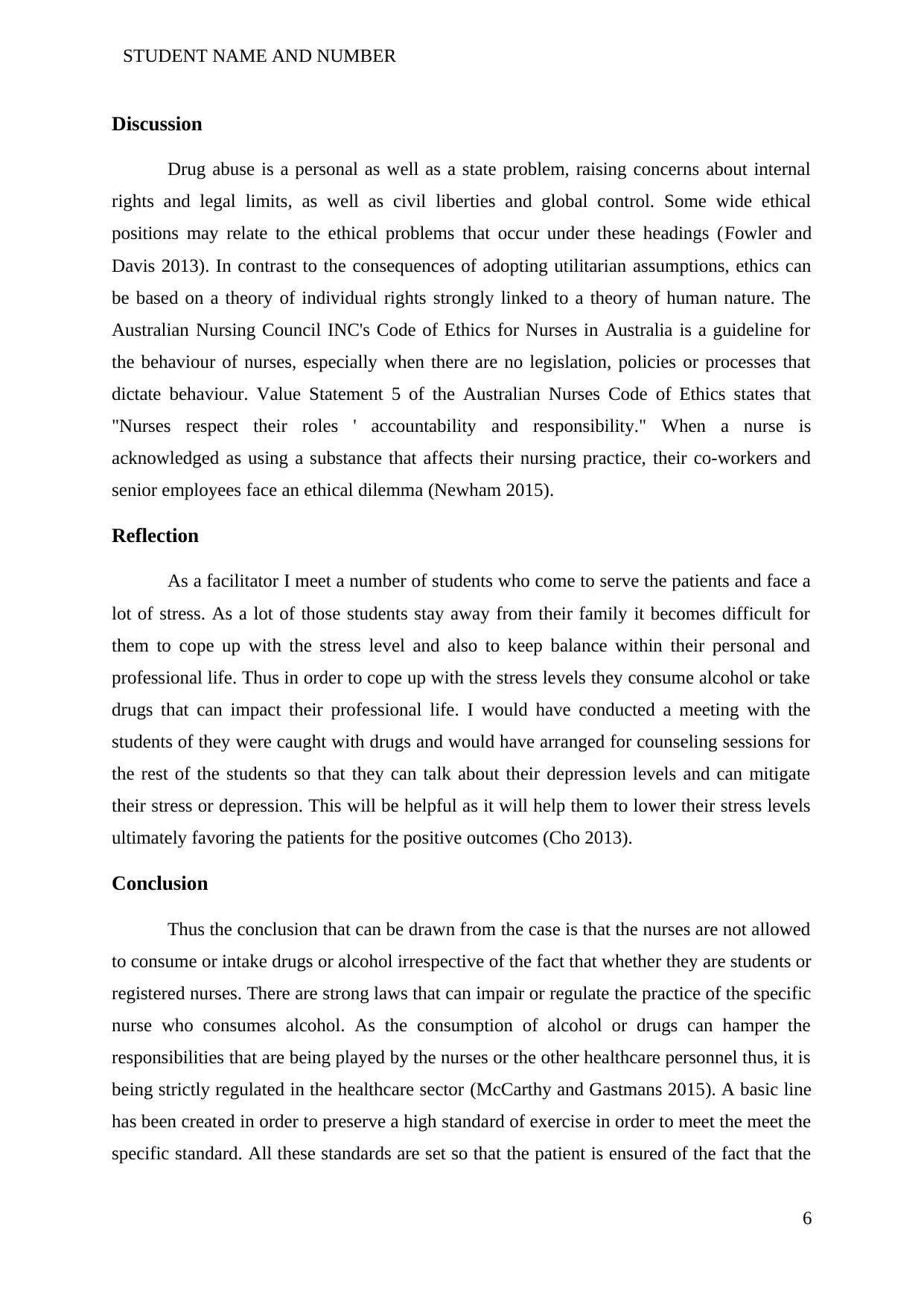
STUDENT NAME AND NUMBER
Discussion
Drug abuse is a personal as well as a state problem, raising concerns about internal
rights and legal limits, as well as civil liberties and global control. Some wide ethical
positions may relate to the ethical problems that occur under these headings (Fowler and
Davis 2013). In contrast to the consequences of adopting utilitarian assumptions, ethics can
be based on a theory of individual rights strongly linked to a theory of human nature. The
Australian Nursing Council INC's Code of Ethics for Nurses in Australia is a guideline for
the behaviour of nurses, especially when there are no legislation, policies or processes that
dictate behaviour. Value Statement 5 of the Australian Nurses Code of Ethics states that
"Nurses respect their roles ' accountability and responsibility." When a nurse is
acknowledged as using a substance that affects their nursing practice, their co-workers and
senior employees face an ethical dilemma (Newham 2015).
Reflection
As a facilitator I meet a number of students who come to serve the patients and face a
lot of stress. As a lot of those students stay away from their family it becomes difficult for
them to cope up with the stress level and also to keep balance within their personal and
professional life. Thus in order to cope up with the stress levels they consume alcohol or take
drugs that can impact their professional life. I would have conducted a meeting with the
students of they were caught with drugs and would have arranged for counseling sessions for
the rest of the students so that they can talk about their depression levels and can mitigate
their stress or depression. This will be helpful as it will help them to lower their stress levels
ultimately favoring the patients for the positive outcomes (Cho 2013).
Conclusion
Thus the conclusion that can be drawn from the case is that the nurses are not allowed
to consume or intake drugs or alcohol irrespective of the fact that whether they are students or
registered nurses. There are strong laws that can impair or regulate the practice of the specific
nurse who consumes alcohol. As the consumption of alcohol or drugs can hamper the
responsibilities that are being played by the nurses or the other healthcare personnel thus, it is
being strictly regulated in the healthcare sector (McCarthy and Gastmans 2015). A basic line
has been created in order to preserve a high standard of exercise in order to meet the meet the
specific standard. All these standards are set so that the patient is ensured of the fact that the
6
Discussion
Drug abuse is a personal as well as a state problem, raising concerns about internal
rights and legal limits, as well as civil liberties and global control. Some wide ethical
positions may relate to the ethical problems that occur under these headings (Fowler and
Davis 2013). In contrast to the consequences of adopting utilitarian assumptions, ethics can
be based on a theory of individual rights strongly linked to a theory of human nature. The
Australian Nursing Council INC's Code of Ethics for Nurses in Australia is a guideline for
the behaviour of nurses, especially when there are no legislation, policies or processes that
dictate behaviour. Value Statement 5 of the Australian Nurses Code of Ethics states that
"Nurses respect their roles ' accountability and responsibility." When a nurse is
acknowledged as using a substance that affects their nursing practice, their co-workers and
senior employees face an ethical dilemma (Newham 2015).
Reflection
As a facilitator I meet a number of students who come to serve the patients and face a
lot of stress. As a lot of those students stay away from their family it becomes difficult for
them to cope up with the stress level and also to keep balance within their personal and
professional life. Thus in order to cope up with the stress levels they consume alcohol or take
drugs that can impact their professional life. I would have conducted a meeting with the
students of they were caught with drugs and would have arranged for counseling sessions for
the rest of the students so that they can talk about their depression levels and can mitigate
their stress or depression. This will be helpful as it will help them to lower their stress levels
ultimately favoring the patients for the positive outcomes (Cho 2013).
Conclusion
Thus the conclusion that can be drawn from the case is that the nurses are not allowed
to consume or intake drugs or alcohol irrespective of the fact that whether they are students or
registered nurses. There are strong laws that can impair or regulate the practice of the specific
nurse who consumes alcohol. As the consumption of alcohol or drugs can hamper the
responsibilities that are being played by the nurses or the other healthcare personnel thus, it is
being strictly regulated in the healthcare sector (McCarthy and Gastmans 2015). A basic line
has been created in order to preserve a high standard of exercise in order to meet the meet the
specific standard. All these standards are set so that the patient is ensured of the fact that the
6
Paraphrase This Document
Need a fresh take? Get an instant paraphrase of this document with our AI Paraphraser
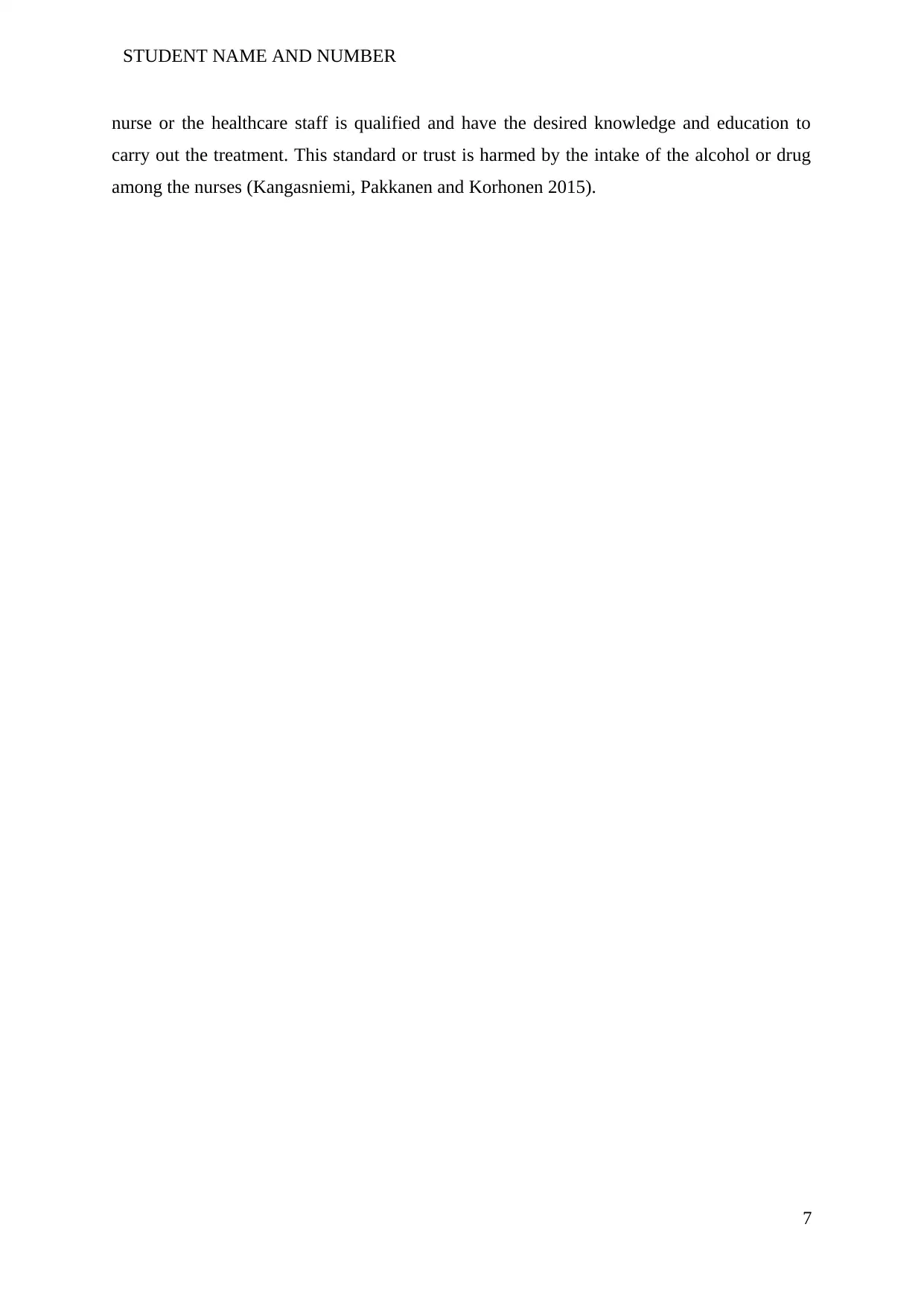
STUDENT NAME AND NUMBER
nurse or the healthcare staff is qualified and have the desired knowledge and education to
carry out the treatment. This standard or trust is harmed by the intake of the alcohol or drug
among the nurses (Kangasniemi, Pakkanen and Korhonen 2015).
7
nurse or the healthcare staff is qualified and have the desired knowledge and education to
carry out the treatment. This standard or trust is harmed by the intake of the alcohol or drug
among the nurses (Kangasniemi, Pakkanen and Korhonen 2015).
7
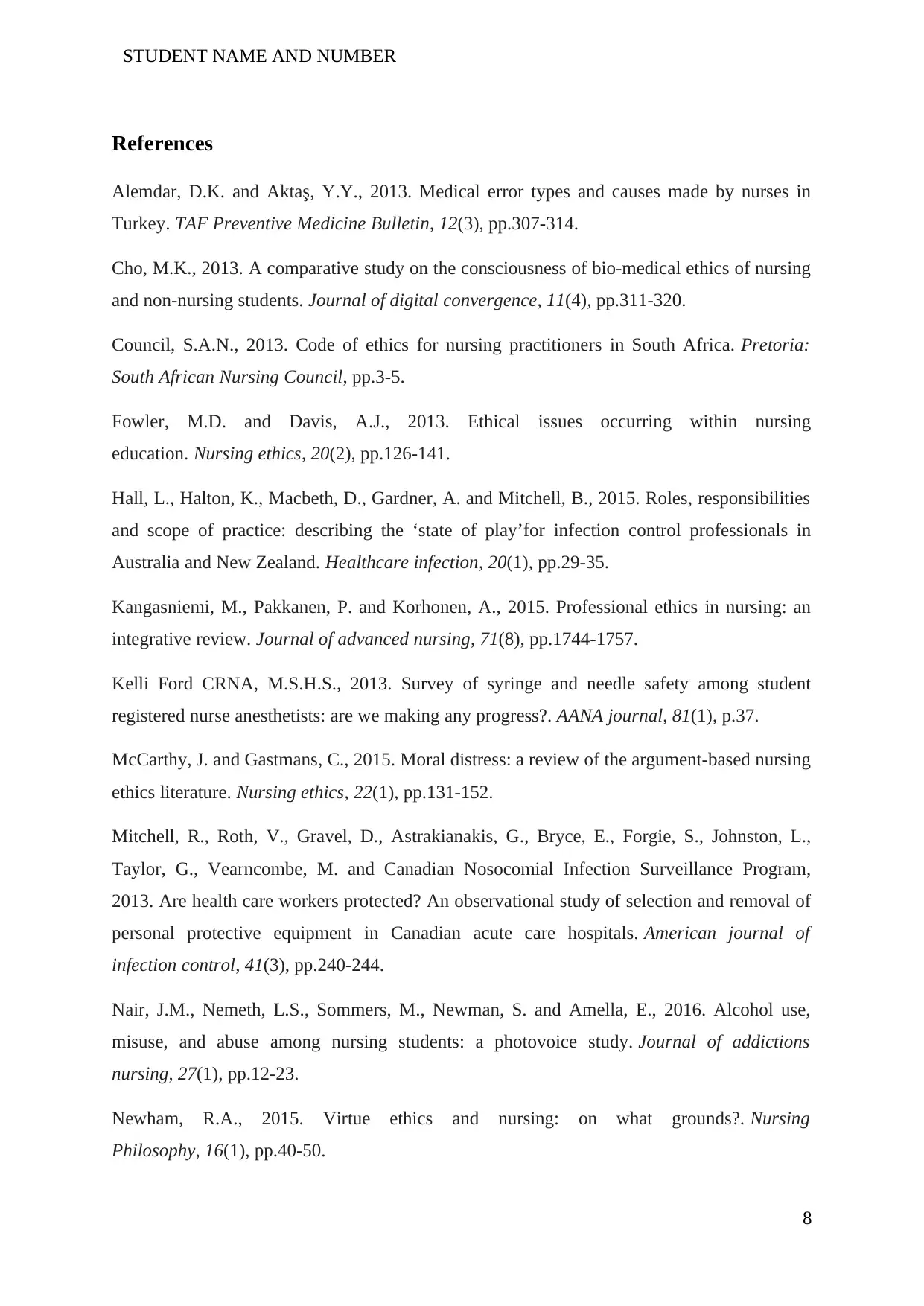
STUDENT NAME AND NUMBER
References
Alemdar, D.K. and Aktaş, Y.Y., 2013. Medical error types and causes made by nurses in
Turkey. TAF Preventive Medicine Bulletin, 12(3), pp.307-314.
Cho, M.K., 2013. A comparative study on the consciousness of bio-medical ethics of nursing
and non-nursing students. Journal of digital convergence, 11(4), pp.311-320.
Council, S.A.N., 2013. Code of ethics for nursing practitioners in South Africa. Pretoria:
South African Nursing Council, pp.3-5.
Fowler, M.D. and Davis, A.J., 2013. Ethical issues occurring within nursing
education. Nursing ethics, 20(2), pp.126-141.
Hall, L., Halton, K., Macbeth, D., Gardner, A. and Mitchell, B., 2015. Roles, responsibilities
and scope of practice: describing the ‘state of play’for infection control professionals in
Australia and New Zealand. Healthcare infection, 20(1), pp.29-35.
Kangasniemi, M., Pakkanen, P. and Korhonen, A., 2015. Professional ethics in nursing: an
integrative review. Journal of advanced nursing, 71(8), pp.1744-1757.
Kelli Ford CRNA, M.S.H.S., 2013. Survey of syringe and needle safety among student
registered nurse anesthetists: are we making any progress?. AANA journal, 81(1), p.37.
McCarthy, J. and Gastmans, C., 2015. Moral distress: a review of the argument-based nursing
ethics literature. Nursing ethics, 22(1), pp.131-152.
Mitchell, R., Roth, V., Gravel, D., Astrakianakis, G., Bryce, E., Forgie, S., Johnston, L.,
Taylor, G., Vearncombe, M. and Canadian Nosocomial Infection Surveillance Program,
2013. Are health care workers protected? An observational study of selection and removal of
personal protective equipment in Canadian acute care hospitals. American journal of
infection control, 41(3), pp.240-244.
Nair, J.M., Nemeth, L.S., Sommers, M., Newman, S. and Amella, E., 2016. Alcohol use,
misuse, and abuse among nursing students: a photovoice study. Journal of addictions
nursing, 27(1), pp.12-23.
Newham, R.A., 2015. Virtue ethics and nursing: on what grounds?. Nursing
Philosophy, 16(1), pp.40-50.
8
References
Alemdar, D.K. and Aktaş, Y.Y., 2013. Medical error types and causes made by nurses in
Turkey. TAF Preventive Medicine Bulletin, 12(3), pp.307-314.
Cho, M.K., 2013. A comparative study on the consciousness of bio-medical ethics of nursing
and non-nursing students. Journal of digital convergence, 11(4), pp.311-320.
Council, S.A.N., 2013. Code of ethics for nursing practitioners in South Africa. Pretoria:
South African Nursing Council, pp.3-5.
Fowler, M.D. and Davis, A.J., 2013. Ethical issues occurring within nursing
education. Nursing ethics, 20(2), pp.126-141.
Hall, L., Halton, K., Macbeth, D., Gardner, A. and Mitchell, B., 2015. Roles, responsibilities
and scope of practice: describing the ‘state of play’for infection control professionals in
Australia and New Zealand. Healthcare infection, 20(1), pp.29-35.
Kangasniemi, M., Pakkanen, P. and Korhonen, A., 2015. Professional ethics in nursing: an
integrative review. Journal of advanced nursing, 71(8), pp.1744-1757.
Kelli Ford CRNA, M.S.H.S., 2013. Survey of syringe and needle safety among student
registered nurse anesthetists: are we making any progress?. AANA journal, 81(1), p.37.
McCarthy, J. and Gastmans, C., 2015. Moral distress: a review of the argument-based nursing
ethics literature. Nursing ethics, 22(1), pp.131-152.
Mitchell, R., Roth, V., Gravel, D., Astrakianakis, G., Bryce, E., Forgie, S., Johnston, L.,
Taylor, G., Vearncombe, M. and Canadian Nosocomial Infection Surveillance Program,
2013. Are health care workers protected? An observational study of selection and removal of
personal protective equipment in Canadian acute care hospitals. American journal of
infection control, 41(3), pp.240-244.
Nair, J.M., Nemeth, L.S., Sommers, M., Newman, S. and Amella, E., 2016. Alcohol use,
misuse, and abuse among nursing students: a photovoice study. Journal of addictions
nursing, 27(1), pp.12-23.
Newham, R.A., 2015. Virtue ethics and nursing: on what grounds?. Nursing
Philosophy, 16(1), pp.40-50.
8
⊘ This is a preview!⊘
Do you want full access?
Subscribe today to unlock all pages.

Trusted by 1+ million students worldwide
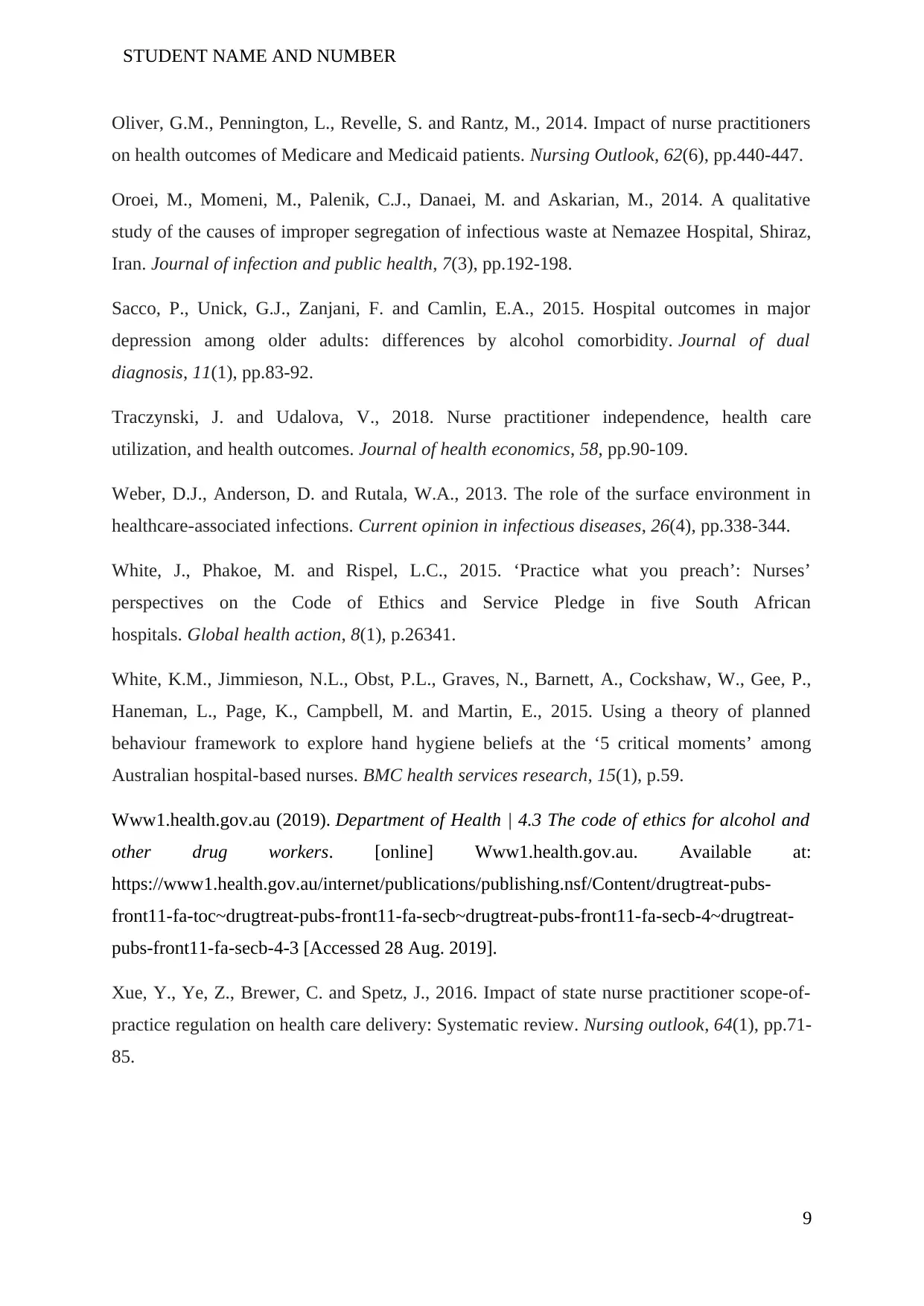
STUDENT NAME AND NUMBER
Oliver, G.M., Pennington, L., Revelle, S. and Rantz, M., 2014. Impact of nurse practitioners
on health outcomes of Medicare and Medicaid patients. Nursing Outlook, 62(6), pp.440-447.
Oroei, M., Momeni, M., Palenik, C.J., Danaei, M. and Askarian, M., 2014. A qualitative
study of the causes of improper segregation of infectious waste at Nemazee Hospital, Shiraz,
Iran. Journal of infection and public health, 7(3), pp.192-198.
Sacco, P., Unick, G.J., Zanjani, F. and Camlin, E.A., 2015. Hospital outcomes in major
depression among older adults: differences by alcohol comorbidity. Journal of dual
diagnosis, 11(1), pp.83-92.
Traczynski, J. and Udalova, V., 2018. Nurse practitioner independence, health care
utilization, and health outcomes. Journal of health economics, 58, pp.90-109.
Weber, D.J., Anderson, D. and Rutala, W.A., 2013. The role of the surface environment in
healthcare-associated infections. Current opinion in infectious diseases, 26(4), pp.338-344.
White, J., Phakoe, M. and Rispel, L.C., 2015. ‘Practice what you preach’: Nurses’
perspectives on the Code of Ethics and Service Pledge in five South African
hospitals. Global health action, 8(1), p.26341.
White, K.M., Jimmieson, N.L., Obst, P.L., Graves, N., Barnett, A., Cockshaw, W., Gee, P.,
Haneman, L., Page, K., Campbell, M. and Martin, E., 2015. Using a theory of planned
behaviour framework to explore hand hygiene beliefs at the ‘5 critical moments’ among
Australian hospital-based nurses. BMC health services research, 15(1), p.59.
Www1.health.gov.au (2019). Department of Health | 4.3 The code of ethics for alcohol and
other drug workers. [online] Www1.health.gov.au. Available at:
https://www1.health.gov.au/internet/publications/publishing.nsf/Content/drugtreat-pubs-
front11-fa-toc~drugtreat-pubs-front11-fa-secb~drugtreat-pubs-front11-fa-secb-4~drugtreat-
pubs-front11-fa-secb-4-3 [Accessed 28 Aug. 2019].
Xue, Y., Ye, Z., Brewer, C. and Spetz, J., 2016. Impact of state nurse practitioner scope-of-
practice regulation on health care delivery: Systematic review. Nursing outlook, 64(1), pp.71-
85.
9
Oliver, G.M., Pennington, L., Revelle, S. and Rantz, M., 2014. Impact of nurse practitioners
on health outcomes of Medicare and Medicaid patients. Nursing Outlook, 62(6), pp.440-447.
Oroei, M., Momeni, M., Palenik, C.J., Danaei, M. and Askarian, M., 2014. A qualitative
study of the causes of improper segregation of infectious waste at Nemazee Hospital, Shiraz,
Iran. Journal of infection and public health, 7(3), pp.192-198.
Sacco, P., Unick, G.J., Zanjani, F. and Camlin, E.A., 2015. Hospital outcomes in major
depression among older adults: differences by alcohol comorbidity. Journal of dual
diagnosis, 11(1), pp.83-92.
Traczynski, J. and Udalova, V., 2018. Nurse practitioner independence, health care
utilization, and health outcomes. Journal of health economics, 58, pp.90-109.
Weber, D.J., Anderson, D. and Rutala, W.A., 2013. The role of the surface environment in
healthcare-associated infections. Current opinion in infectious diseases, 26(4), pp.338-344.
White, J., Phakoe, M. and Rispel, L.C., 2015. ‘Practice what you preach’: Nurses’
perspectives on the Code of Ethics and Service Pledge in five South African
hospitals. Global health action, 8(1), p.26341.
White, K.M., Jimmieson, N.L., Obst, P.L., Graves, N., Barnett, A., Cockshaw, W., Gee, P.,
Haneman, L., Page, K., Campbell, M. and Martin, E., 2015. Using a theory of planned
behaviour framework to explore hand hygiene beliefs at the ‘5 critical moments’ among
Australian hospital-based nurses. BMC health services research, 15(1), p.59.
Www1.health.gov.au (2019). Department of Health | 4.3 The code of ethics for alcohol and
other drug workers. [online] Www1.health.gov.au. Available at:
https://www1.health.gov.au/internet/publications/publishing.nsf/Content/drugtreat-pubs-
front11-fa-toc~drugtreat-pubs-front11-fa-secb~drugtreat-pubs-front11-fa-secb-4~drugtreat-
pubs-front11-fa-secb-4-3 [Accessed 28 Aug. 2019].
Xue, Y., Ye, Z., Brewer, C. and Spetz, J., 2016. Impact of state nurse practitioner scope-of-
practice regulation on health care delivery: Systematic review. Nursing outlook, 64(1), pp.71-
85.
9
1 out of 10
Related Documents
Your All-in-One AI-Powered Toolkit for Academic Success.
+13062052269
info@desklib.com
Available 24*7 on WhatsApp / Email
![[object Object]](/_next/static/media/star-bottom.7253800d.svg)
Unlock your academic potential
Copyright © 2020–2025 A2Z Services. All Rights Reserved. Developed and managed by ZUCOL.





